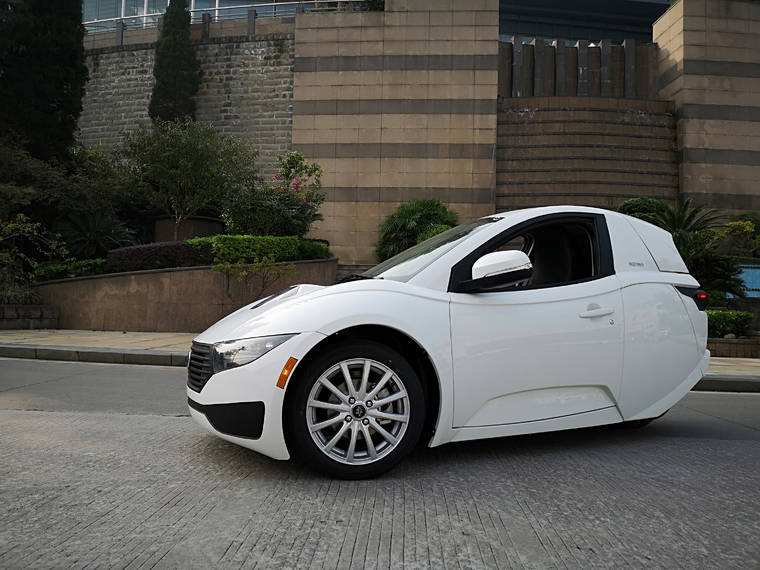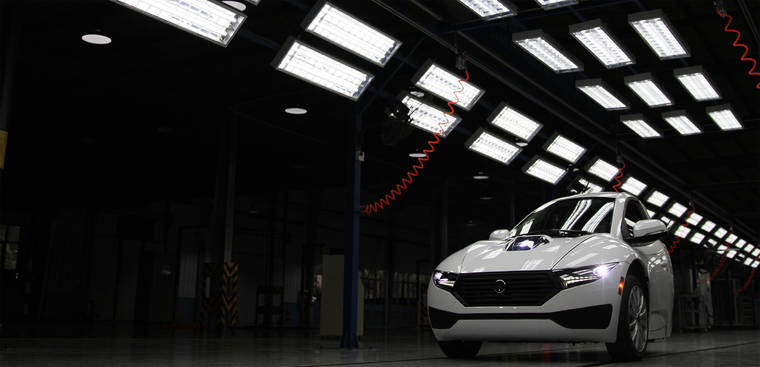There’s a new kid on the zero-emissions vehicle block — and it has three wheels.
The Solo, from Canadian designer and manufacturer ElectraMeccanica, is a single-passenger all-electric vehicle with a range of 100 miles and a top speed of 80 mph. It retails for $18,500, and people in a select few U.S. cities on the West Coast and in Arizona can see it for themselves.
The car is slightly more than 10 feet long and 57.5 inches wide at the front wheels — considerably smaller than a typical passenger vehicle. For example, a 2020 Honda Accord sedan is 192.2 inches long and 73.3 inches wide.
“When you’re driving it, you feel like you’re sitting in the cockpit of a fighter jet or in a Formula One car,” said Paul Rivera, CEO of ElectraMeccanica. “It’s really cool and really different.”
But a big part of the marketing strategy for the Solo is based on efficiency and practicality.
That ties into why ElectraMeccanica opened its newest storefront Tuesday in San Diego.
“There’s a lot of interest in electric vehicles in the San Diego market and there’s just a great number of commuters,” Rivera said. “If you think about the 805 freeway, the 5 freeway in the morning, the 94, you look 200, 300 yards in front of you and there are a lot of vehicles with one occupant and three to four empty seats.”
The company quotes statistics showing that each day, 119 million North Americans commute using personal vehicles — and 105 million of them commute alone.
The Solo looks to attract “early adopters” — consumers who are attracted to the latest technology — looking for an option in an urban environment.
“There are just so many things that you do solo,” Rivera said. “You go get your coffee solo, you go to the gym solo, you go visit friends solo. This is a purpose-built vehicle and it fits beautifully between passenger cars on one end of the spectrum and micro-mobility (scooters, electric bikes, etc.) on the other end.”
Powered by a 17.3 kWh battery that turns a single rear wheel, the Solo features a heated seat, Bluetooth stereo, rear-view camera, power steering, power brakes and air conditioning. For safety, it has front and rear crumple zones, side-impact protection, torque-limiting stability control and a roll bar.
ElectraMeccanica is based in Vancouver, B.C., but the Solo is manufactured in China by the Zongshen Industrial Group at a mammoth factory in Chongqing. The first production shipments of Solos arrived in the U.S. last month, with some of the vehicles sent to retail kiosks such as the Westfield UTC site.
“People can go see it, they can go feel it, touch it and schedule a test drive,” Rivera said.
Like Tesla, customers don’t drive the vehicle off a lot but place a pre-order to have it delivered at a later date. The Solo requires a $250 deposit, which is refundable.
Rivera would not say how many deposits have been made for the Solo but said “the waiting list is pretty long” and estimated an order placed today would probably get delivered “well into the middle of next year.”
One potential drawback: While a conventional four-wheeled electric vehicle is eligible for a federal tax credit of up to $7,500 and a rebate in California of up to $2,000, the Solo receives no federal tax credit and a California rebate of just $750 — the same as an electric motorcycle.
That’s because the Solo is categorized as a motorcycle in the eyes of the U.S. government and the state of California.
Ivan Drury, who looks at automotive trends as senior manager at Edmunds.com, is skeptical about the single-seater’s prospects.
“That’s a hefty premium,” Drury said of the Solo’s smaller amount of government incentives, especially when cost-conscious drivers have plenty of used cars on the market that are priced at $15,000 and lower.
“There’s a lot there that makes it a very tough sell,” Drury said. “If you’re looking for cheap, reliable transportation, you’re probably not set up to have an EV (electric vehicle) charging station in your house or apartment building so you’ve got that logistical nightmare to deal with,” Drury said. “And if you’re well-to-do, you probably already drive a Tesla.”
Last year, Mercedes Benz announced it would stop selling the all-electric Smart car, which had two seats, in North America, largely due to slow sales.
“Small doesn’t sell in America,” Drury said.
Rivera said he thinks the Smart car EV didn’t cut it “because it didn’t make enough of a statement” aesthetically. “I think we offer a uniquely styled vehicle and it’s really cool-looking and different-looking.” Plus, he said the Solo offers enough space to carry luggage or groceries.
In fact, ElectraMeccanica will soon come out with a fleet version of the Solo. It’s the same size as the existing vehicle but the hatchback is removed to create more space for cargo to serve commercial customers for food delivery, security guards, mechanics going to job sites that don’t require a lot of tools, etc.
“We think that’s going to be a home run,” Rivera said. “We also intend to create a sharing program for the vehicle as well, with partners. So there’s three parts of our ecosystem.”
ElectraMeccanica also plans to launch an assembly operation in either the Nashville, Tenn., or Phoenix, Ariz., area to serve the U.S. market while the facility in China will supply vehicles to Europe and Asia. “It just makes a lot of sense that we have a made in the USA product,” Rivera said.
ElectraMeccanica’s new San Diego storefront is one of six retail locations the company is opening in November in California and Arizona. The company already had four storefronts in existence — in Century City and Sherman Oaks, Calif., Scottsdale, Ariz., and suburban Portland, Ore.





